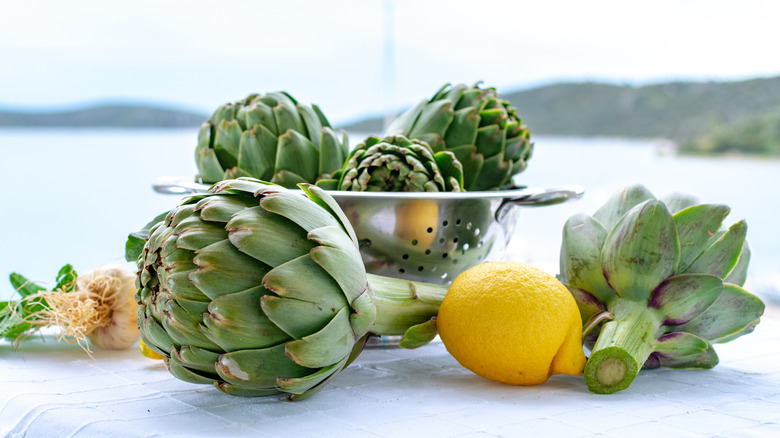Here's How To Stop Artichokes From Turning Brown, According To Andrew Zimmern
Artichoke season hits the United States twice a year, according to Ask the Food Geek, with prime time being March through June and September to October. This sometimes intimidating green bulbous thistle comes off as quite mythical in appearance, looking like a cross between a pine cone and an exotic flower. And per National Geographic, it's also part of actual Greek mythology. There is a tale involving Zeus and his love interest Cynara. In a rage from finding her sneaking out of Mount Olympus to go back home, Zeus turned her into an artichoke for all eternity. The fable is what prompted the artichoke's scientific name, Cynara cardunculus. The plant's long history also includes a time when it was a favorite food of the Romans, served pickled with honey and vinegar, National Geographic says.
Today, we serve these beauties in dips and casseroles. And as Healthline points out, artichokes are full of nutrient-rich vitamins and minerals that can help fuel your body.
But as wonderful as artichokes are, they are also a little terrifying to both prepare and consume. It's definitely not a food you eat whole. And if you have ever prepared fresh artichokes, you know that they (like avocados) can start to quickly turn a brown color that's less than appetizing. (Perhaps that's Cynara's revenge?) But there are ways you can avoid brown spots from appearing, according to the king of Bizarre Foods, Andrew Zimmern.
Andrew Zimmern's artichoke tip involves lemons and water
Cook's Illustrated shares that the browning or darkening that appears after you cut into your artichoke is a reaction of certain enzymes in the veggie's cell wall being exposed to air. This oxidizing results in the bud turning colors, however, the site also shares that there is a way to slow it down. Enter Andrew Zimmern's technique.
In a YouTube video, the celebrity chef and self-professed "artichoke nut" takes viewers on a cooking boot camp to demonstrate how to properly prepare the vegetable and avoid those brown spots altogether. Zimmern advises to take a bowl of water and acidulate it by squeezing the juice of a couple of lemons inside and then toss in the lemon halves as well. Zimmern then recommends removing some of the leaves and cutting the artichokes in half and proceeding to rub lemon directly on the cut sides of the plant. He also removes the fibrous and inedible choke in the middle before putting the artichoke in the acidulated bath. Do this step before grilling/mashing/braising/etc. and you'll be able to fully prevent the oxidization process from ever happening.
Cook's Illustrated reveals that lemon is so effective for preventing the darkening of artichokes because it contains citric and ascorbic acids that hinder oxidation. However, they note that if you don't have any lemons handy, you can also use vinegar or parsley in water, but these will only minimize — and not prevent — the browning process.

